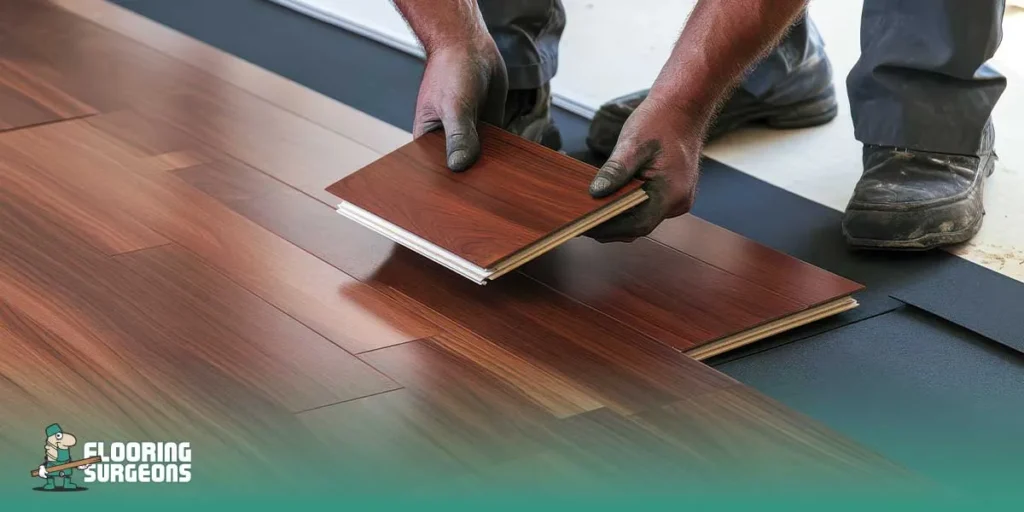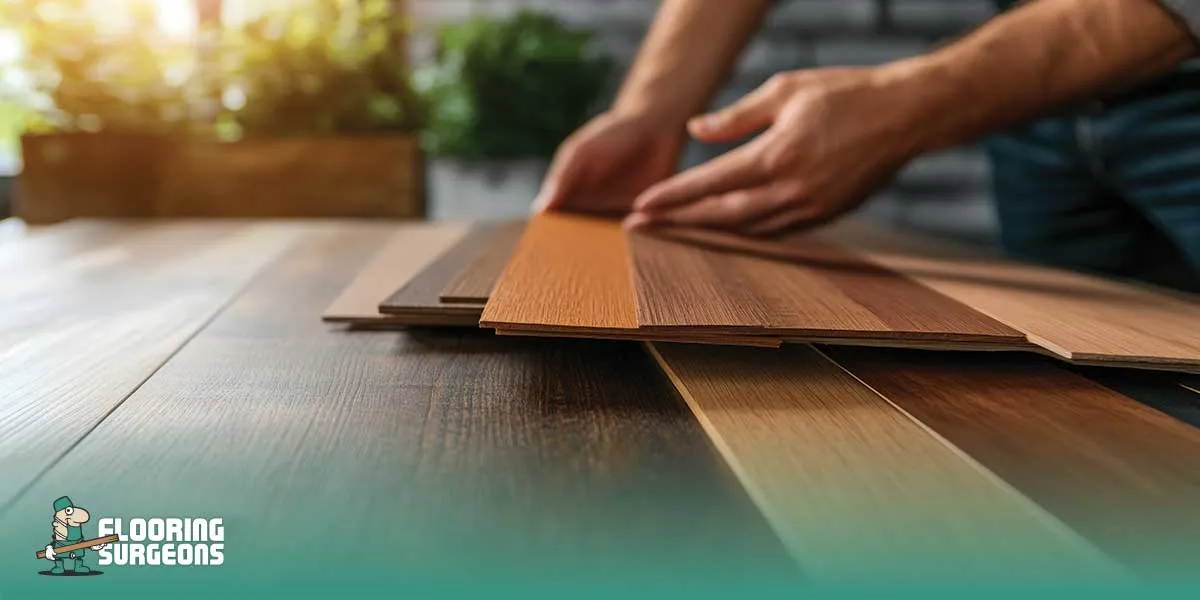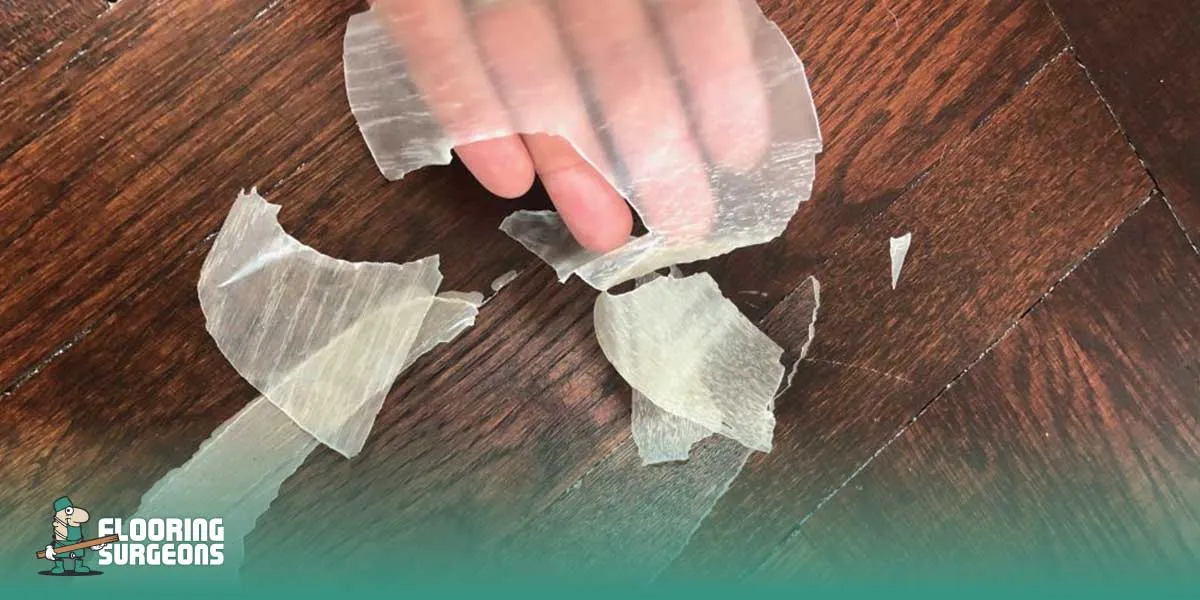At first glance, laminate vs engineered wood flooring can look surprisingly similar. Both options are designed to mimic the beauty of natural timber with realistic grains and textures. It’s no wonder many homeowners even ask, “Is engineered oak the same as laminate flooring?” but beneath the surface, these two products are built very differently.
Understanding the real differences in engineered wood flooring vs laminate can help you choose the right material for your lifestyle, your space, and your long-term expectations. In this guide, we break down how each one is constructed, how they age, how durable they are, and what kind of value they offer — so you can confidently decide which flooring is the better fit for your home.
Key Differences Between Laminate and Engineered Wood Flooring
When deciding between laminate or engineered wood, it helps to understand how differently they’re built and how that affects their performance. Engineered wood offers a real-wood surface layer, giving it a more authentic look and the ability to be refinished, while laminate uses a high-resolution image layer that delivers impressive style at a more affordable price point. Many homeowners wonder, “is laminate flooring better than engineered wood?” The truth is that each excels in different areas: laminate is typically more resistant to scratches and everyday wear, whereas engineered wood brings the warmth and natural feel of genuine timber.
To understand these contrasts more clearly, it’s useful to look at how each type of flooring is constructed. Let’s explore the Structure and Material Composition of Engineered vs Laminate Flooring.
Structure and Material Composition of Engineered vs Laminate Flooring
The most significant difference between engineered and laminate flooring lies in their construction.
- Engineered wood flooring is made of multiple layers: a real hardwood veneer on top (usually oak or walnut) pressed over plywood or high-density fiberboard (HDF).
This gives it the look and feel of solid wood while improving stability against temperature and humidity changes. - Laminate flooring, on the other hand, is entirely synthetic. It uses an HDF core, covered with a photographic wood image, and a protective wear layer on top.
It doesn’t contain real wood, but modern technology — such as embossed-in-register (EIR) textures makes many laminates surprisingly realistic.
In short, engineered wood is real wood at the surface, while laminate looks like wood through a printed design.

Appearance and Realistic Wood Look – Engineered Oak vs Laminate
If authenticity is your priority, engineered oak flooring wins. Because it’s made with a real oak veneer, every plank is unique with natural knots, colour variations, and grain depth that change over time.
Laminate flooring, while visually impressive, offers a more uniform and controlled appearance. Its pattern repeats every few planks since it’s a high-resolution print, not a natural surface.
However, today’s premium laminates (especially 12mm boards with EIR finishes) achieve a near-realistic texture. For example, Embossed Grey Oak Laminate mimics real oak’s brushed look beautifully but when touched, it feels smoother and slightly less warm than natural wood.
If you want timeless charm and natural variation → go with engineered oak.
If you prefer consistency, modern design, and low cost → laminate flooring delivers that perfectly.
Durability and Lifespan Comparison Between Laminate and Engineered Wood Floors
Both flooring types are highly durable, but they perform differently over time.
- Engineered wood flooring can last 20–30 years or longer if well-maintained. Its top veneer (usually 2–6mm thick) can be sanded and refinished several times to remove scratches or refresh its look. This means the floor can be restored rather than replaced.
- Laminate flooring typically lasts 10–20 years. It’s highly resistant to daily wear — scratches, stains, and fading — thanks to its tough top layer. However, once the surface is damaged, it cannot be refinished; the affected boards must be replaced.
In high-traffic homes or rental properties, laminate flooring offers excellent short-term durability at a lower price.
But for long-term investment, engineered wood provides unmatched longevity and can actually increase your home’s resale value.
Moisture Resistance and Environmental Conditions
When it comes to moisture, laminate generally performs better.
Its synthetic layers resist spills and humidity, making it a safe choice for kitchens or hallways. Some modern laminates even come with waterproof technology, allowing limited use in bathrooms or utility rooms.
Engineered wood, while more moisture-resistant than solid wood, still needs careful handling. Constant exposure to water or high humidity can cause the wood veneer to swell or warp. That’s why it’s ideal for living rooms, bedrooms, and dining areas, not for wet spaces.
In summary:
- Laminate = better for moisture-prone areas.
- Engineered wood = better for warmth, comfort, and natural aesthetics.
Installation | Engineered or Laminate?
Laminate flooring wins for ease of installation. Most laminate boards use a click-lock system, meaning they can be installed as a floating floor with minimal tools — perfect for DIY homeowners.
Engineered wood, however, can be installed in several ways:
- Glue-down, for maximum stability.
- Nail-down, for a traditional hardwood feel.
- Floating, similar to laminate, is for modern installations.
While it takes longer and may require professional help, the result is a sturdier, more refined finish.
Cost Comparison Between Engineered Wood and Laminate Flooring
Cost often decides the winner for many homeowners.
- Laminate flooring: typically £15–£30 per m² — budget-friendly and ideal for quick renovations.
- Engineered wood flooring: £35–£70 per m² — a premium choice that adds value and elegance.
Although engineered floors cost more upfront, their ability to be refinished multiple times means they last longer and cost less over time.
So if you’re renovating on a budget, laminate works well.
If you’re investing for long-term value, engineered wood pays off in the end.
Environmental Impact | Engineered vs Laminate
Engineered wood is considered the more eco-friendly option because it uses real timber efficiently. Only the top veneer is solid wood, while the core layers come from recycled plywood or HDF — reducing waste and forest use.
Laminate flooring, while mostly synthetic, can also be sustainable if it’s E1- or E0-certified (low formaldehyde emissions) and made with recycled wood fibres. Some brands now offer recyclable laminates with non-toxic resins.
In short, both can be eco-conscious just check for FSC certification or low-VOC adhesives when choosing.

Which One Should You Choose | Engineered or Laminate Flooring?
Your choice depends on what matters most to you:
| Priority | Best Option |
| Authentic wood look | Engineered Oak Flooring |
| Budget-friendly renovation | Laminate Flooring |
| Longevity & resale value | Engineered Wood |
| Moisture resistance | Laminate |
| Easy DIY installation | Laminate |
| Refinishable surface | Engineered Wood |
If you want your floor to look and feel like real timber, engineered wood is hard to beat—but when comparing engineered wood flooring vs laminate, it’s clear that both offer unique strengths. Engineered floors provide the warmth and authenticity of natural wood, making them ideal for homeowners who value genuine texture. At the same time, laminate remains one of the most durable, budget-friendly, and low-maintenance choices for modern UK homes.
It’s also common for people to ask, “is engineered oak the same as laminate flooring?” While they may look similar on the surface, engineered oak is a real-wood product, whereas laminate uses advanced imaging technology to replicate the look of timber.
Explore the full range of Engineered Wood Flooring and Laminate Flooring collections at Flooring Surgeons, and order your free samples to compare colours, textures, and finishes up close.
Pros and Cons of Engineered Wood vs Laminate Flooring
When deciding between engineered wood and laminate flooring, it’s important to weigh their practical strengths and weaknesses — not just how they look. Both options have unique benefits depending on where and how they’re used. Below, we break down the key pros and cons of engineered wood vs laminate flooring to help you make an informed decision.
Advantages of Engineered Wood Flooring
When comparing engineered wood flooring vs laminate, it becomes clear that each has its own strengths—but engineered wood stands out in several premium aspects. While laminate vs engineered wood often comes down to budget, durability, and appearance, engineered flooring offers benefits that go beyond surface-level beauty. From its authentic timber feel to its long-term performance, engineered wood provides qualities that laminate simply can’t match. Below are the key advantages that make engineered wood a preferred choice for many homeowners.
1. Authentic Natural Appearance
Engineered wood flooring delivers the warmth and richness of real hardwood because its top layer is made of genuine timber such as oak or walnut. Every plank has unique knots, textures, and tones, giving the floor character that laminate simply can’t replicate.
2. Long-Term Durability and Refinishability
Unlike laminate, engineered wood can be sanded and refinished multiple times — extending its lifespan to 20–30 years or more. Minor scratches and wear marks can easily be removed, making it ideal for homeowners who value long-term beauty.
3. Higher Property Value
Installing engineered wood floors increases a home’s resale value. Estate agents and buyers in the UK often see it as a premium feature, similar in appeal to solid hardwood but with better stability.
4. Better Acoustic and Thermal Comfort
Engineered flooring feels solid underfoot and offers better insulation and sound absorption than laminate. It’s also compatible with underfloor heating, making it perfect for colder climates.
5. Eco-Conscious Manufacturing
Because it uses only a thin veneer of real wood, engineered flooring consumes fewer natural resources than solid hardwood, while still offering the same luxurious look.
Disadvantages of Engineered Wood Flooring
When weighing up laminate or engineered wood, it’s easy to focus on the premium look and natural feel that engineered flooring provides. But to make a fully informed decision, you also need to understand where it may fall short. In the broader comparison of engineered wood vs laminate flooring, laminate sometimes performs better in terms of practicality, maintenance, and overall cost-efficiency. And while engineered wood can be paired with the most durable hardwood floor finish, some limitations still remain. Here are the main disadvantages of engineered wood to consider before committing to your final choice.
1. Higher Upfront Cost
Engineered wood is more expensive than laminate flooring, both in materials and installation. Expect to pay roughly £35–£70 per m², compared to laminate’s lower price range.
2. Moisture Sensitivity
Although more stable than solid wood, engineered flooring can still swell or warp in overly humid or wet environments. It’s not recommended for bathrooms, wet rooms, or areas with frequent spills.
3. Professional Installation Required
Engineered floors often require skilled installation — especially with glue-down or nail-down methods. This adds to labour costs, unlike laminate, which can be DIY-installed.
4. Colour Change Over Time
Because the top layer is real wood, engineered flooring naturally changes tone as it ages or is exposed to sunlight. Some homeowners love this patina; others may prefer the colour consistency of laminate.
Advantages of Laminate Flooring Compared to Engineered Wood
Choosing the right flooring often comes down to practicality, and this is where laminate truly shines. In many real-world situations, laminate outperforms engineered wood in terms of cost, durability, and everyday convenience. While engineered flooring offers natural beauty, laminate provides a smarter, more resilient option for busy homes and high-traffic spaces. Below are the key advantages that make laminate a strong competitor when compared to engineered wood.
1. Affordable and Cost-Effective
Laminate flooring remains one of the best value-for-money options in the UK market. With prices starting at £15–£30 per m², it’s ideal for large spaces or rental properties where budget control is essential.
2. Easy and Fast Installation
Thanks to the click-lock system, laminate is a favourite among DIY enthusiasts. It can be installed as a floating floor over existing surfaces without glue or nails, reducing both mess and labour costs.
3. Highly Resistant to Scratches, Stains, and Fading
Laminate’s wear layer is incredibly tough — making it suitable for busy households with pets or children. It resists daily wear, spills, and UV fading better than most wood-based floors.
4. Excellent for High-Traffic and Moisture-Prone Areas
Laminate performs exceptionally well in hallways, kitchens, and commercial spaces. Its synthetic construction makes it less sensitive to temperature and humidity than engineered wood.
5. Low Maintenance
Unlike engineered floors that may need refinishing, laminate only requires basic sweeping and occasional damp mopping. No special oils or treatments are needed, saving time and maintenance costs.

Disadvantages of Laminate Flooring in Real Homes
While laminate flooring offers impressive practicality and excellent value, it’s not without its limitations. Real homes with varied climates, heavy foot traffic, or design-focused requirements may reveal some drawbacks that aren’t obvious at first glance. Understanding these downsides is essential, especially when comparing laminate to higher-end alternatives like engineered wood. Before making your final decision, consider the following disadvantages that homeowners commonly experience with laminate flooring.
1. Less Authentic Feel and Texture
Even with advanced printing technology, laminate flooring can’t fully match the depth, texture, and warmth of natural wood. Underfoot, it often feels lighter and slightly hollower than engineered oak.
2. Non-Refinishable Surface
Once the top wear layer is damaged, laminate boards cannot be sanded or repaired — they must be replaced. This limits long-term flexibility, especially in high-use areas.
3. Lower Lifespan Compared to Engineered Wood
While durable, laminate flooring generally lasts 10–20 years, depending on usage. Engineered flooring, with proper care, often doubles that lifespan.
4. Sound and Comfort Limitations
Laminate floors can produce more echo or hollow sound, especially without quality underlay. They also feel cooler to the touch, which can reduce comfort in colder rooms.
5. Environmental Considerations
Although many brands now use eco-friendly materials, some lower-grade laminates may contain synthetic resins or adhesives that emit volatile organic compounds (VOCs). Always check for E1/E0 or FSC certification when buying.
Cost and Long-Term Value of Laminate vs Engineered Wood Flooring
When comparing laminate vs engineered wood flooring, cost is often the deciding factor—but the actual value goes beyond the upfront price. At the same time, laminate floors may seem cheaper at first glance, but engineered wood often pays off in the long run through its durability, refinishing potential, and resale value. Let’s break down both the installation and maintenance costs to see which one offers better overall return on investment (ROI).
Installation and Material Costs | Engineered or Laminate?
Laminate flooring is the clear winner for affordability and ease of installation.
- Material cost: £15–£30 per m² (depending on brand, thickness, and finish).
- Installation cost: around £10–£15 per m² if done professionally, or £0 if installed DIY.
- That makes laminate ideal for homeowners on a budget or for rental properties where speed and cost efficiency matter most.
Many laminate floors use click-lock floating systems, which require no glue or nails. You can install them over existing floors with minimal preparation — reducing labour time by up to 40% compared to wood-based options.
Engineered wood flooring, by contrast, has a higher initial investment.
- Material cost: £35–£70 per m² (depending on veneer thickness, wood species, and finish).
- Installation cost: £20–£40 per m², since it typically requires professional fitting, especially for glue-down or nail-down methods.
However, this extra expense yields a more durable, premium finish and greater longevity. Engineered floors are also seen as a value-adding feature in UK homes, often enhancing resale appeal and market perception, particularly for properties in mid- to high-end price brackets.
In short:
If you want a quick, affordable renovation → choose laminate.
If you’re investing in long-term value and natural appeal → go for engineered wood.
Maintenance Costs and ROI Comparison Between Laminate and Engineered Flooring
When comparing engineered wood flooring vs laminate, long-term value becomes a major deciding factor. Many homeowners ask, “is laminate flooring better than engineered wood?” Upfront, laminate is cheaper — but because it can’t be refinished, worn or damaged planks must be replaced, often giving it a shorter 10–20-year lifespan.
Engineered wood, especially engineered oak, can last 25–40 years and be refinished several times, which is why engineered oak is the same as laminate flooring. It is a common misconception. Its ability to be restored rather than replaced offers a stronger ROI and better appeal for resale. Laminate may be stylish and practical, but engineered wood generally adds more long-term value to a home.
Maintenance cost comparison:
| Task | Laminate Flooring | Engineered Wood Flooring |
| Regular Cleaning | Simple sweeping & mopping | Occasional cleaning + oil/wax treatment |
| Scratch Repair | Replace board | Sand & refinish |
| Average Lifespan | 10–20 years | 25–40 years |
| Refinishable | No | Yes |
| Long-Term ROI | Medium | High |
Final Insight:
Choosing between engineered or laminate flooring comes down to whether you value low upfront cost or long-term quality.
- Laminate = short-term savings and practicality.
- Engineered wood = long-term return, natural beauty, and better resale potential.
If you’re unsure which one fits your lifestyle, Flooring Surgeons’ experts can guide you through both options from cost planning to sample selection helping you make a confident, informed choice for your home.
Best Applications for Engineered and Laminate Flooring in UK Homes
Both engineered wood and laminate flooring perform differently depending on the environment, moisture levels, and daily foot traffic of a room. In British homes where temperature and humidity often fluctuate, choosing the right material for the right space is key to longevity and comfort.
Here’s where each flooring type truly shines across different areas of a modern UK home.
Ideal Rooms and Spaces for Engineered Wood Flooring vs Laminate
Engineered Wood Flooring – Best for Living Spaces and Bedrooms
Engineered wood brings warmth, texture, and timeless beauty — making it the go-to option for living rooms, dining rooms, and bedrooms.
Its real wood veneer adds a natural luxury feel, enhancing the aesthetic value of any interior.
- Living rooms: The natural acoustic and thermal insulation of engineered oak makes large spaces feel cosy and quiet.
- Bedrooms: Offers a soft, warm underfoot experience, especially when paired with underfloor heating.
- Hallways or stairs (light to moderate use): Works well if properly sealed to handle occasional dirt and moisture.
Example: A brushed oak engineered floor in a London townhouse instantly adds warmth and depth without overwhelming smaller rooms. However, avoid installing it in bathrooms, wet rooms, or basements, where high moisture can damage the veneer.
Laminate Flooring | Perfect for Kitchens, Hallways, and Family Spaces
Laminate flooring is ideal for high-traffic and moisture-prone areas that experience daily spills, dirt, and heavy use.
- Kitchens: Modern waterproof laminates handle splashes and temperature changes far better than wood.
- Hallways and entryways: Laminate’s scratch-resistant, stain-resistant top layer makes it practical for busy family homes or flats.
- Kids’ rooms and rental properties: Durable, affordable, and easy to replace if damaged.
Its low-maintenance surface and DIY-friendly installation also make it a wise choice for quick renovations or budget-conscious updates in UK properties.
Tip: For open-plan homes, many homeowners mix both — using engineered oak in living areas and laminate in connected kitchens for visual continuity with better functionality.

Eco & Lifestyle Considerations for Laminate vs Engineered Wood
Beyond aesthetics, climate and lifestyle factors in the UK can strongly influence which floor performs better long term.
1. Humidity and Temperature Changes
In regions with variable humidity — like coastal areas or older houses — laminate flooring is more dimensionally stable. It’s an HDF core and sealed surface that resists expansion, making it suitable for homes without climate control.
Engineered wood, while more stable than solid wood, still requires balanced humidity (40–60%) to prevent warping. It’s perfect for insulated, centrally heated homes.
2. Lifestyle and Usage Habits
Families with children or pets often prefer laminate flooring, as it’s easier to clean and resists scratches from claws and toys.
Homeowners prioritising elegance, resale value, and tactile warmth typically choose engineered oak flooring, especially in long-term residences.
3. Sustainability and Environmental Impact
Eco-conscious homeowners in the UK may lean toward engineered wood, which uses real timber efficiently and can be refinished instead of replaced.
However, high-quality laminate with E0/E1 certification and FSC-approved materials can also be a sustainable choice if recycling options exist.
4. Heating Compatibility
Both flooring types work well with underfloor heating. Still, engineered wood distributes warmth more evenly and feels softer underfoot ideal for colder regions in the UK, such as Scotland or northern England.
Conclusion
At the end of the day, the question “Is laminate flooring better than engineered wood?” doesn’t have a one-size-fits-all answer; it depends entirely on your priorities, space, and lifestyle. Both flooring types offer distinct advantages, and understanding where each shines will help you make the right investment for your home.
Summary of the Key Differences Between Engineered and Laminate Floors
| Feature | Engineered Wood Flooring | Laminate Flooring |
| Material Composition | Real wood veneer over a layered plywood base | High-density fibreboard with a printed image layer |
| Appearance | Authentic wood texture and natural variation | Photographic pattern, consistent but less natural |
| Durability & Refinishability | Can be sanded and refinished 3–4 times | Non-refinishable; damaged boards must be replaced |
| Water & Heat Resistance | Moderate moisture tolerance | Highly moisture-resistant; ideal for kitchens |
| Installation | Glue-down, nail-down, or floating | Click-lock system; fast and DIY-friendly |
| Lifespan | 25–40 years | 10–20 years |
| Cost Range (Material + Install) | £55–£100 per m² total | £25–£45 per m² total |
| Maintenance | Occasional refinishing, oiling | Simple cleaning, no refinishing |
| Ideal Rooms | Living rooms, bedrooms, lounges | Kitchens, hallways, rentals, offices |
| Overall Value (ROI) | Higher resale value | More budget-friendly upfront |
In short:
- Engineered wood gives you authenticity, longevity, and prestige.
- Laminate flooring offers affordability, durability, and practicality.
Final Recommendations: Choosing Between Engineered or Laminate Flooring
If you’re seeking timeless elegance and long-term value, engineered wood flooring is the better investment. Its natural grain, warmth, and ability to be refinished make it perfect for homeowners who view flooring as a long-term feature — not a quick fix.
It’s also ideal for living rooms, bedrooms, and open-plan spaces where aesthetics and acoustic comfort matter most. On the other hand, laminate flooring is unbeatable for budget-conscious renovations, rental properties, or high-traffic family zones. It handles scratches, moisture, and daily wear far better, especially in kitchens, hallways, and offices.
For many UK homeowners, the most innovative solution is a hybrid approach — engineered wood in social or visible spaces, and laminate in practical or moisture-prone areas. This mix delivers both the elegance of real wood and the convenience of synthetic durability. Expert Tip: Before making your final decision, always order free samples from Flooring Surgeons to see how each flooring type looks and feels under your home’s lighting and layout. It’s the simplest way to compare tone, texture, and comfort before installation.

















